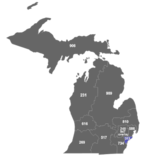Zug Island
1888 establishments in MichiganArtificial islands of the United StatesFord Motor CompanyIslands of Wayne County, MichiganIslands of the Detroit River ... and 1 more
River islands of Michigan

Zug Island is a heavily industrialized island within the city of River Rouge at the southern city limits of Detroit in the U.S. state of Michigan. It is located where the mouth of the River Rouge spills into the Detroit River. Zug Island is not a natural island in the river; it was formed when a shipping canal was dug along the southwestern side of the island, allowing ships to bypass several hundred yards of twisting waterway near the mouth of the natural course of the lowest portions of the River Rouge.
Excerpt from the Wikipedia article Zug Island (License: CC BY-SA 3.0, Authors, Images).Zug Island
Zug Island Road,
Geographical coordinates (GPS) Address Nearby Places Show on map
Geographical coordinates (GPS)
| Latitude | Longitude |
|---|---|
| N 42.282777777778 ° | E -83.111388888889 ° |
Address
Zug Island Road
Zug Island Road
48209
Michigan, United States
Open on Google Maps






